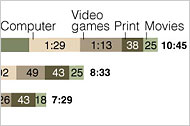The average young American
now spends practically every waking minute — except for the time in school —
using a smart phone, computer, television or other electronic device,
according to a
new study from the Kaiser Family Foundation.
Those ages 8 to 18 spend more than seven and a
half hours a day with such devices, compared with less than six and a half
hours five years ago, when the study was last conducted. And that does not
count the hour and a half that youths spend texting, or the half-hour they
talk on their cellphones.
And because so many of them are multitasking —
say, surfing the Internet while listening to music —
they pack on average nearly 11 hours of media
content into that seven and a half hours.
...The study’s findings shocked its authors,
who had concluded in 2005 that use could not possibly grow further, and
confirmed the fears of many parents whose children are constantly tethered
to media devices. It found, moreover, that heavy media use is associated
with several negatives, including behavior problems and lower grades.
The third in a series, the study found that
young people’s media consumption grew far more in the last five years than
from 1999 to 2004, as sophisticated mobile technology like iPods and smart
phones brought media access into teenagers’ pockets and beds.
Dr. Michael Rich, a pediatrician at Children’s
Hospital Boston who directs the Center on Media and Child Health, said that
with media use so ubiquitous, it was time to stop arguing over whether it
was good or bad and accept it as part of children’s environment, “like the
air they breathe, the water they drink and the food they eat.”
... While most of the young people in the study
got good grades, 47 percent of the heaviest media users — those who consumed
at least 16 hours a day — had mostly C’s or lower, compared with 23 percent
of those who typically consumed media three hours a day or less. The
heaviest media users were also more likely than the lightest users to report
that they were bored or sad, or that they got into trouble, did not get
along well with their parents and were not happy at school.
The study could not say whether the media use
causes problems, or, rather, whether troubled youths turn to heavy media
use.
---The report is based on a survey of more than
2,000 students in grades 3 to 12 that was conducted from October 2008 to May
2009.
On average, young people
spend about two hours a day consuming media on a mobile device, the study
found. They spend almost another hour on “old” content like television or
music delivered through newer pathways like the Web site
Hulu
or iTunes. Youths now spend more time listening to or watching media on
their cellphones, or playing games, than talking on them.
...The study found that young people used less
media in homes with rules like no television during meals or in the bedroom,
or with limits on media time.
...The heaviest media users, the study found,
are black and Hispanic youths and “tweens,” or those ages 11 to 14.
---“One of the hot topics
today is
Twitter, but when we first went into the field and began
interviewing, Twitter didn’t exist,” Ms. Rideout said.

Enlarge
Raz, N et al. in
Neurobiology of Aging
Shown in red, the frontal lobe houses the "executive system" of
the brain; it decreases in volume as we age. This region helps the
brain decide which tasks to focus on and when to suppress irrelevant
information. Click to see a graph showing how the frontal lobe
changes with aging.
Raz, N et al. in
Neurobiology of Aging
Shown in
red, the frontal lobe houses the "executive system" of the brain; it
decreases in volume as we age. This region helps the brain decide
which tasks to focus on and when to suppress irrelevant information.
Click to see a graph showing how the frontal lobe changes with
aging.

Enlarge
Gogtay et al in PNAS
The volume of gray matter, or the neurons of the brain, peaks in
the early years of development.
Gogtay et al in PNAS
The
volume of gray matter, or the neurons of the brain, peaks in the
early years of development.
October 2, 2008
Don't believe the multitasking hype, scientists say. New
research shows that we humans aren't as good as we think we are at doing
several things at once. But it also highlights a human skill that gave us an
evolutionary edge.
As technology allows people to do more tasks at the same
time, the myth that we can multitask has never been stronger. But
researchers say it's still a myth — and they have the data to prove it.
Humans, they say, don't do lots of things simultaneously.
Instead, we switch our attention from task to task extremely quickly.
-----------------
Multitasking: A Human Delusion?
"People can't multitask very well, and when people say
they can, they're deluding themselves," said neuroscientist Earl Miller.
And, he said, "The brain is very good at deluding itself."
Miller, a Picower professor of neuroscience at MIT, says
that for the most part, we simply can't focus on more than one thing at a
time. What we can do, he said, is shift our focus from one thing to the next
with astonishing speed.
"Switching from task to task, you think you're actually
paying attention to everything around you at the same time. But you're
actually not," Miller said. "You're not paying attention to one or two
things simultaneously, but switching between them very rapidly."
Miller said there are several reasons the brain has to
switch among tasks. One is that similar tasks compete to use the same part
of the brain. "Think about writing an e-mail and talking on the phone at the
same time. Those things are nearly impossible to do at the same time," he
said.
"You cannot focus on one while doing the other. That's
because of what's called interference between the two tasks," Miller said.
"They both involve communicating via speech or the written word, and so
there's a lot of conflict between the two of them."
Researchers say they can actually see the brain
struggling. And now they're trying to figure out the details of what's going
on.
Putting The Mind To The Test
At a lab at the University of Michigan, researchers are
using an MRI scanner to photograph test subjects' brains as they take on
different tasks.
During a recent test, Daniel Weissman, the neuroscientist
in charge of the experiment, explained that a man lying inside the scanner
would be performing different tasks, depending on the color of two numbers
he sees on a screen.
...................
MRI studies like this one, Weissman said, have shown
that when the man in the scanner sees green, his brain has to pause before
responding — to round up all the information it has about the ..... task.
.........
If the tasks were simpler, they might not require this
sort of full-throttle switching. But, Weissman said, even simple tasks can
overwhelm the brain when we try to do several at once.
.....
The part of the brain that does this is called the
"executive system." It's a bit like one of those cartoon conductors telling
the orchestra: louder, softer, faster, slower. You come in here. You be
quiet for a few measures.
.....
The executive system also helps us achieve a goal by
ignoring distractions.
"For example, if we're performing a task where we want to
watch TV and ignore voices that are coming from, say, our children nearby,"
Weissman said, "our frontal region brain may configure the brain to
prioritize visual information and dampen down auditory information."
.....
A Role In Evolution
.....
For early humans, that sort of miscalculation could have
meant becoming a tiger's lunch. These days, the consequences are more likely
to be stress, a blunder — or maybe a car crash.




